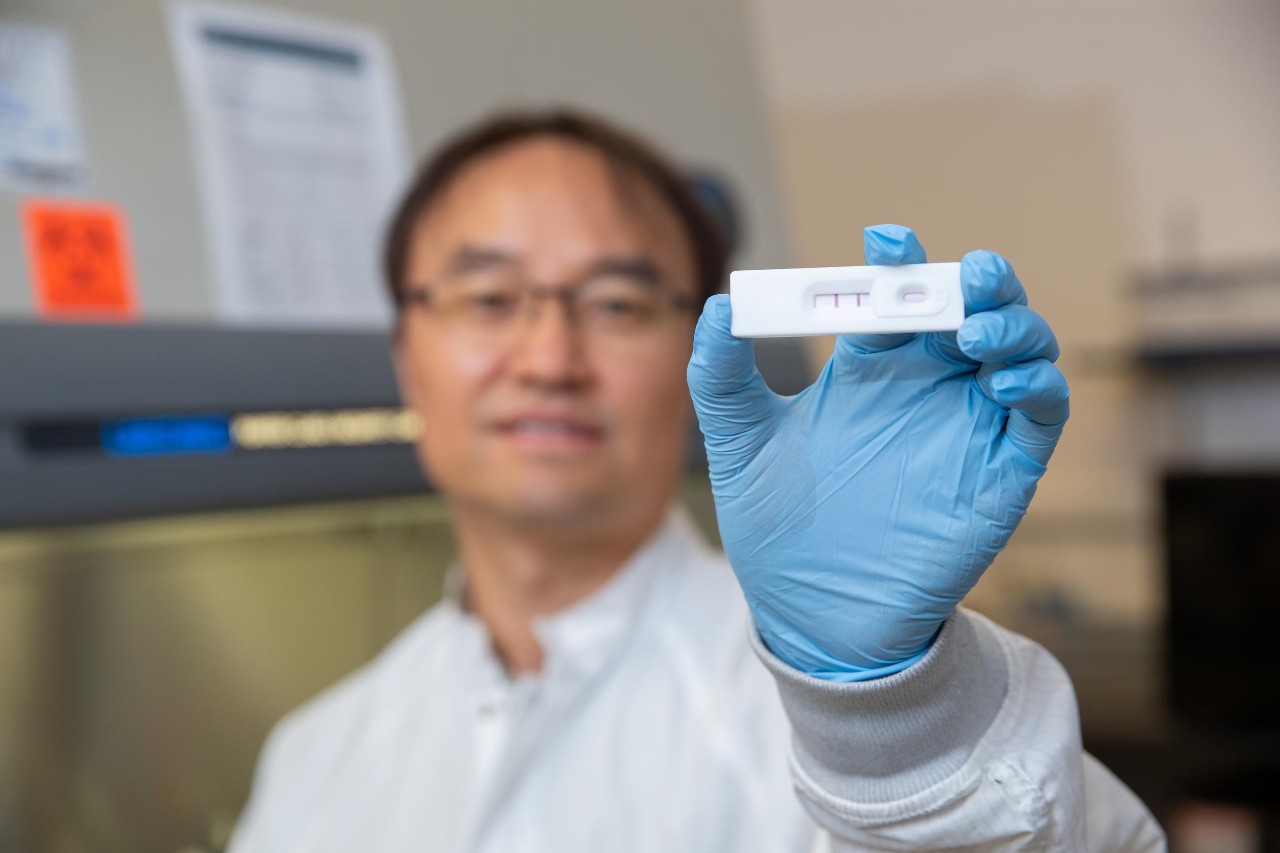
New at-home test protects oral health
UC engineers create device that can diagnose gingivitis
Engineers at the University of Cincinnati have developed a new device that can warn consumers about early risks of tooth decay from diseases such as gingivitis and periodontitis.

University of Cincinnati engineers have developed a test that can warn consumers about periodontal disease, which if left untreated can lead to tooth loss, stroke, heart disease and other illnesses. Graphic/Andrew Steckl and Daewoo Han
Gingivitis, the earliest form of gum disease, is caused by bacteria. But not just any bacteria.
The problem for researchers was getting a device to single out the particular type responsible for the disease, said Andrew Steckl, an Ohio Eminent Scholar and distinguished research professor in UC’s College of Engineering and Applied Science.
“It’s been quite the challenge to get to the point where we can detect this toxin created by the bacteria responsible for gingivitis,” he said.
Steckl and UC Senior Research Associate Daewoo Han collaborated with Sancai Xie, a principal scientist at Procter & Gamble Co., and described their results in a paper published in the Royal Society of Chemistry journal Sensors and Diagnostics.

Senior Research Associate Daewoo Han, left, and Distinguished Research Professor Andrew Steckl collaborated on a new at-home test for gingivitis in Steckl's NanoLab. Photo/Andrew Higley/UC Marketing + Brand
Steckl’s research team has been exploring biosensing for various applications. They studied stress hormones in sweat in collaboration with the Air Force Research Lab at Wright-Patterson Air Force Base. Now they are studying saliva.
“There are good reasons to use saliva,” he said. “It’s relatively plentiful and easy to obtain through noninvasive methods. And saliva has a lot of important elements that can act as indicators of your health.”
Bacteria from gingivitis can travel through the bloodstream, leading to cardiovascular disease and other serious health problems, Steckl said.
I tell my students that research is search, search and re-search until you find the answer.
Andrew Steckl, UC Distinguished Research Professor
But saliva is a complicated biofluid, Han said.
“We wanted to target a biomarker in saliva. But saliva is hard to use,” said Han, the study’s lead author.
Researchers pretreated the sample using potato starch to remove a protein called amylase that could interfere with the test results. Their test uses antibodies that react to the endotoxins found in the bacteria.
Developing a sensor required precise selectivity and sensitivity, Steckl said.
“Daewoo worked very hard on many dead-ends before he had success,” Steckl said. “I tell my students that research is search, search and re-search until you find the answer.”

Senior Research Associate Daewoo Han has been developing an at-home test for periodontal disease at the NanoLab in UC's College of Engineering and Applied Science. Photo/Andrew Higley/UC Marketing + Brand
At-home health testing has been available for generations for uses such as detecting pregnancy. But the COVID-19 pandemic introduced a wide audience of consumers to the concept of monitoring their health with new technology.
The at-home testing industry is expected to generate $45 billion annually by 2031, according to Allied Market Research.
Steckl said he sees a lot of opportunity for new consumer products.
“Our results definitely show promise,” Steckl said. “Sometimes it comes easy. Most of the time you have to persevere.”
Featured image at top: UC Senior Research Associate Daewoo Han shows the gingivitis test. Photo/Andrew Higley/UC Marketing + Brand

UC Distinguished Research Professor and Ohio Eminent Scholar Andrew Steckl is exploring medical advancements made possible by new nanotechnologies. Photo/Andrew Higley/UC Marketing + Brand
Next Lives Here
The University of Cincinnati is leading public urban universities into a new era of innovation and impact. Our faculty, staff and students are saving lives, changing outcomes and bending the future in our city's direction. Next Lives Here.
Related Stories
UC's art collection on display at the Contemporary Arts Center
January 5, 2026
University of Cincinnati leaders joined WVXU's Cincinnati Edition to talk about the university’s 200-year-old art collection, a new exhibition at the Contemporary Arts Center and the release of a companion book exploring the collection’s role in education and public engagement.
What's behind the mysterious rise of migraines?
January 5, 2026
Weather patterns such as extreme heat and storm conditions have been linked to migraine attacks, and research shows those environmental conditions are becoming more common. As National Geographic recently reported, one of the leading theories behind this mysterious rise is that climate change may be playing a role.
Top six 2025 nephrology drug approvals
January 5, 2026
“2025 has been a landmark year for kidney disease therapeutics, marked by a comprehensive slate of FDA approvals covering endothelin-receptor blockade, complement inhibition, GLP-1-based metabolic protection, and B-cell-directed therapy,” Prakash Gudsoorkar, MD, associate professor of clinical medicine at the University of Cincinnati College of Medicine and staff nephrologist at UC Health, recently told MedCentral.
